Diamonds are the quintessential elements in our lives. They are great for celebrations, gifting, or investments. Truth be told, not all that is glittery will make the cut as the best diamond.
You may have known the importance of 4 C's to determine the quality of a diamond. One of the most crucial elements of 4 C's is clarity, which determines the beauty and allure of top quality diamonds. In this blog, we’ll discuss diamond clarity, the various grades, and how to choose the best clarity diamond.
Table of Content:
What Is Diamond Clarity?
While imperfection is the hallmark of every creation in this world, perfect things are impossible to find. Diamonds too are no exceptions. The imperfections of diamonds are known as inclusions and blemishes. It is important to remember that no diamond is perfectly pure, but the closer it comes to purity, the better its clarity.
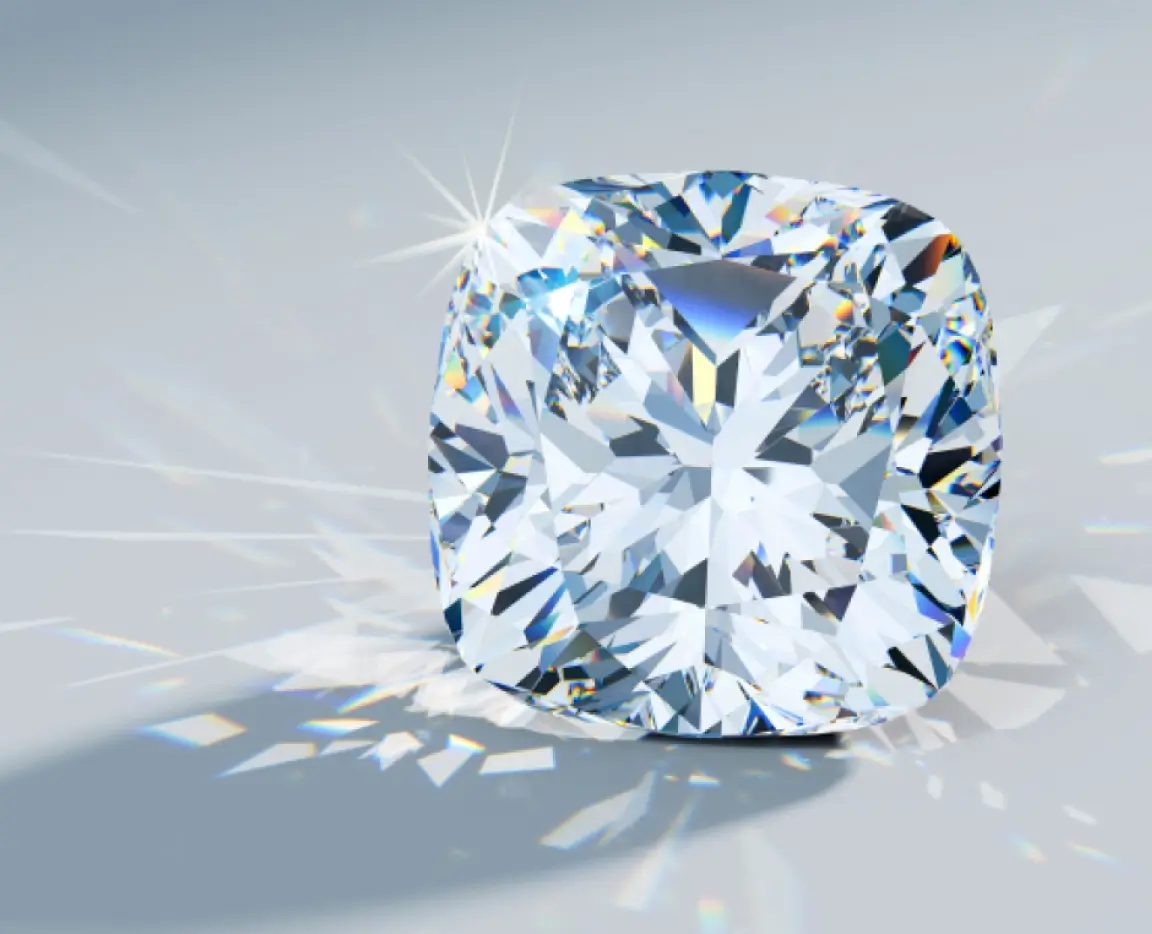
EXPLORE DIAMOND CLARITY
While pure quality diamonds have lower inclusions or blemishes, impure ones have more flaws. The grade to determine the purity of a diamond is known as ‘Diamond Clarity’.
Though the imperfections are not visible to the naked eye, they are visible under 10x magnification and impact your diamond’s radiance. The best clarity diamond is the one with fewer flaws. It is also the priciest. The diamond clarity is thus graded based on the number of visible inclusions or blemishes, their types, size, etc. As such, a grading system is devised to determine diamond clarity, known as the Diamond Clarity Chart.
The Diamond Clarity Chart
Created by the Gemological Institute of America (GIA), the Diamond Clarity Chart is the most widely used grading system to determine diamond clarity. It has eleven different grades to describe the clarity of a diamond. The grades are: Created by the Gemological Institute of America (GIA), the Diamond Clarity Chart is the most widely used grading system to determine diamond clarity. It has eleven different grades to describe the clarity of a diamond. The grades are:
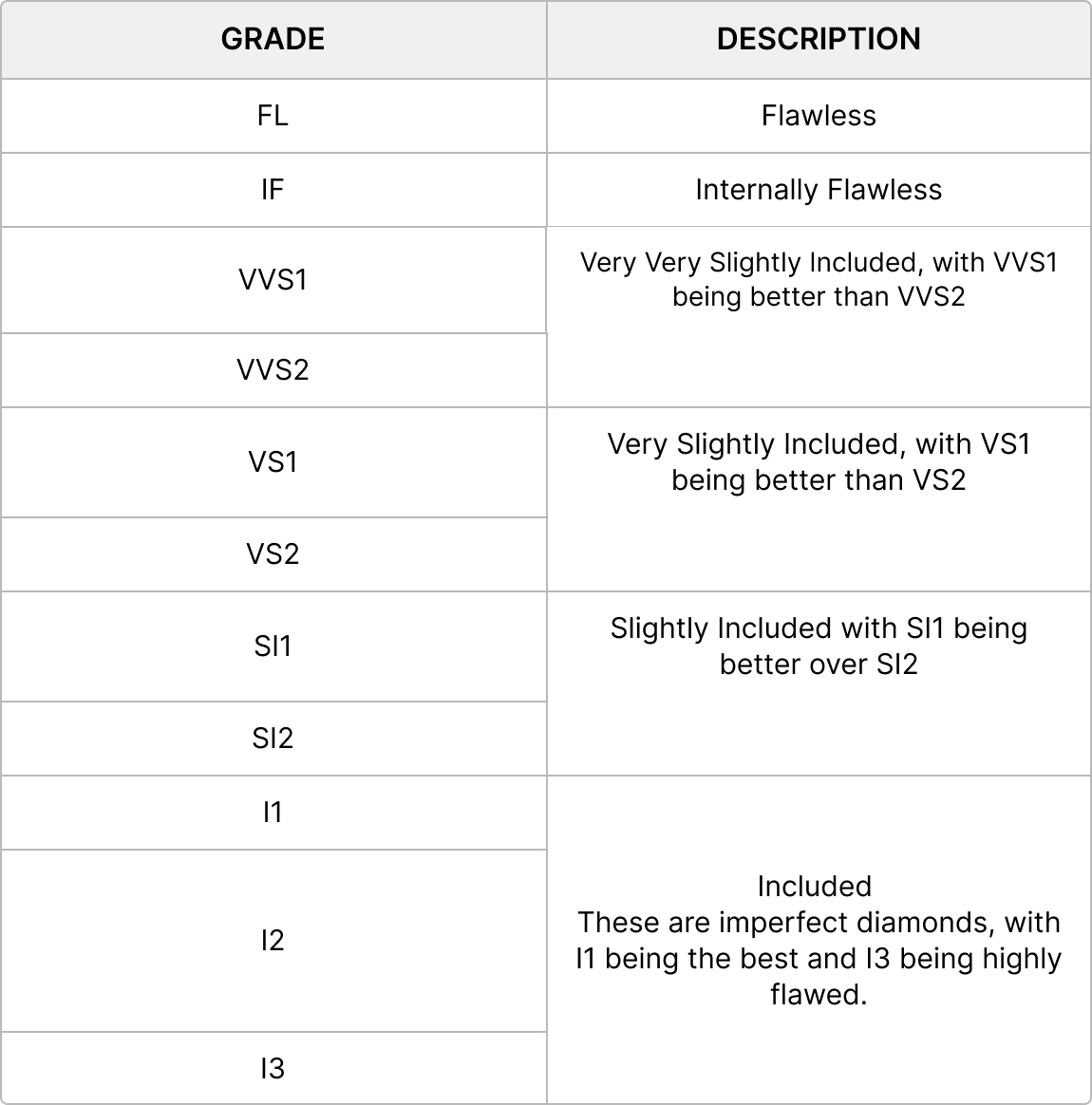
If you are to buy the best clarity diamond based on the above diamond clarity chart, you’ll be in for a rude shock. The chart minimally categorizes diamonds. Quiet literally, there is more to diamond clarity than it meets the eye.
Going by the chart, you may think that higher clarity grades FL and IF are the best clarity diamonds. But a deeper insight into the grades may change your mind.
-
FL grade indicates that a diamond is flawless. Such flawless diamonds are extremely rare to occur in nature. Even lab grown diamonds are not always flawless. Various parameters determine the creation of flawless diamonds in a laboratory and are difficult to create. Hence, FL grade stones are the most expensive diamonds among other grades of clarity.
-
IF grade indicates internally flawless diamonds, but there might be some flaws on the surface. These types of diamonds are also quite rare in occurrence and are pricey
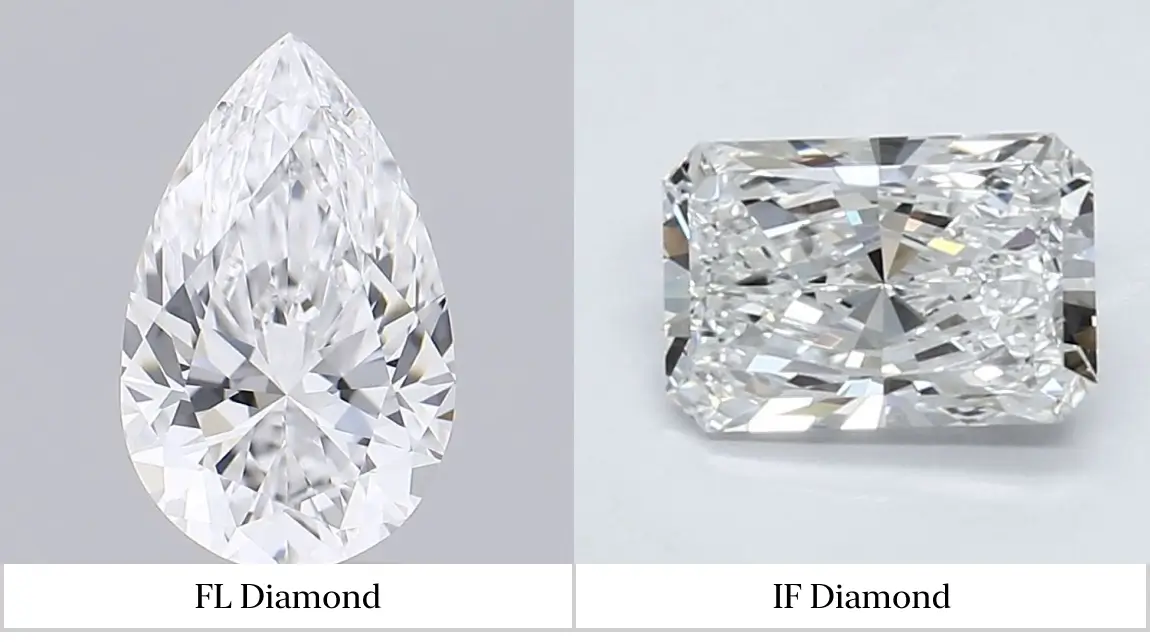
-
VVS1 and VVS2 are the most common types of diamonds. The inclusions in these diamonds are not visible to the naked eye but visible under 10x magnification.
-
If you are to buy lab diamonds, you will find VS1 and VS2 grade stones in abundance. In VS1 grade, inclusions are very slight and require magnification aids to detect them. Whereas in VS2 grade, inclusions are easily detectable with aids compared to VS1.
-
You may see inclusions without requiring special equipment in SI1 and SI2 diamond clarity grades. These are affordable diamonds.
-
The I1, I2, and I3 grade diamonds are of inferior clarity with inclusions or blemishes visible to the naked eye. If we may suggest to you, avoid buying these diamonds.
If you find the GIA clarity chart obscure, you may ask, ‘How do I choose the best clarity diamond?’. The answer is to look for eye-clean diamonds. Now, what is eye-clean? Before we delve into that, let us first understand the different types of inclusions or blemishes, how they affect selecting a diamond and why eye-clean matters.
Types of Inclusions or Blemishes
Lab diamonds are formed in a laboratory by simulating the environment in which natural diamonds are formed. Under extreme heat and pressure, the diamonds are formed with or without some imperfections.
While inclusions are internal imperfections, blemishes are surface flaws caused by wear and tear or during cutting and polishing processes.
Inclusions Types
-
Needle - These are long and thin rod-like inclusions in the diamond. When they appear in clusters, they impact diamond clarity.
-
Cavity - It is a small opening into the diamond from the surface. A cavity traps dust or dirt and requires constant cleaning.
-
Chip - This inclusion is similar to a cavity but is formed during the cutting or polishing process. It is either due to regular wear and tear or by the mentioned processes.
-
Pinpoint - Pinpoints are tiny light or dark crystals in a diamond usually seen under the microscope. Clusters of pinpoints create a cloudy haze that affects clarity.
-
Feather - This is a small crack inside a diamond. Feather inclusions, when reaching the surface, will affect the diamond’s durability.
-
Graining - It involves the growth of small grains of crystals inside a diamond that appear like faint lines.
-
Crystal - These are natural inclusions where tiny crystals grow inside a diamond.
- Knots - Knots are the growth of crystals on the surface of the diamond. Usually, diamonds with knots are awarded a lower grade clarity.
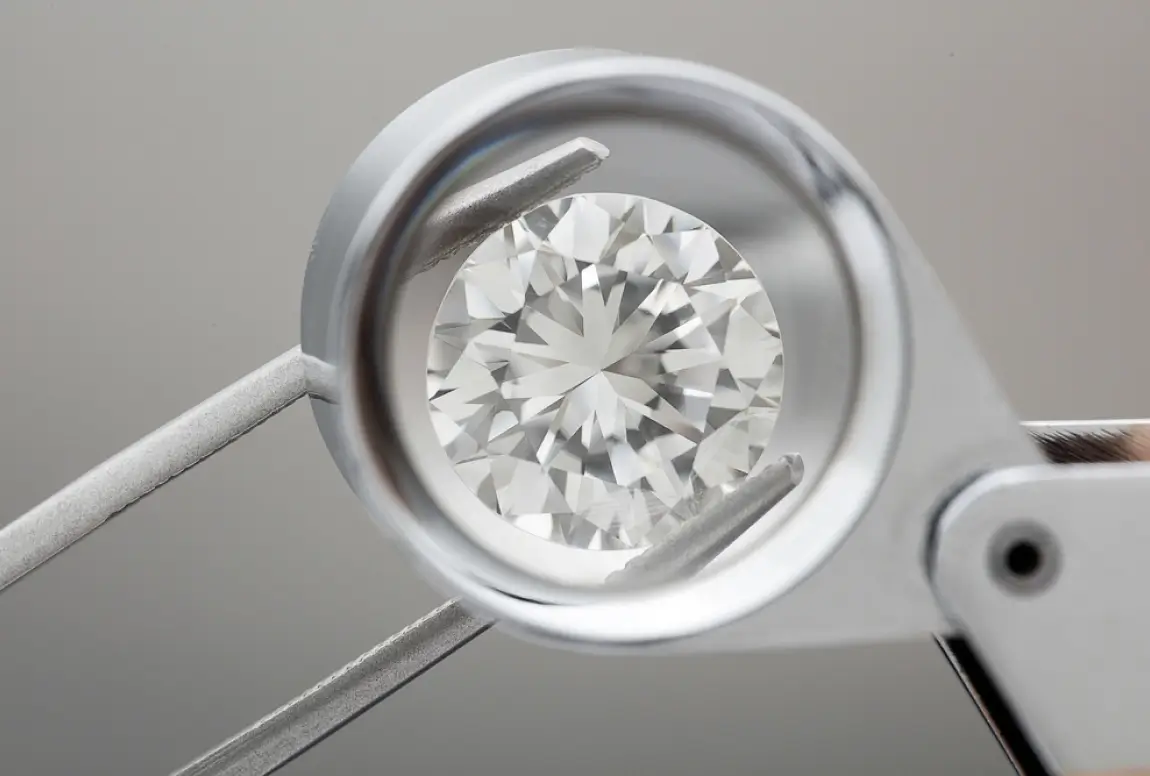
Blemishes Types
Blemishes are confined to the surface of the diamonds. They include:
- Scratches
- Polishing lines
- Burnt marks
- Abrasions
- Nicks
- Pits
- Surface graining
While grading diamonds, gemologists consider the type of inclusions or blemishes, their size, position, and color. Also, factors like the size of the diamond and its color affect the diamond's clarity grade. And here lies the importance of eye-cleanliness in choosing the best clarity diamond.
Eye-Clean: Clarity That Matters
If you see a diamond and cannot find any inclusions or blemishes with the naked eye under normal lighting conditions, it is an eye-clean diamond. Eye cleanliness is what matters when selecting a diamond. However, there is a caveat; ‘eye clean’ is subjective and varies from person to person.
An eye-clean diamond clarity chart goes like this:
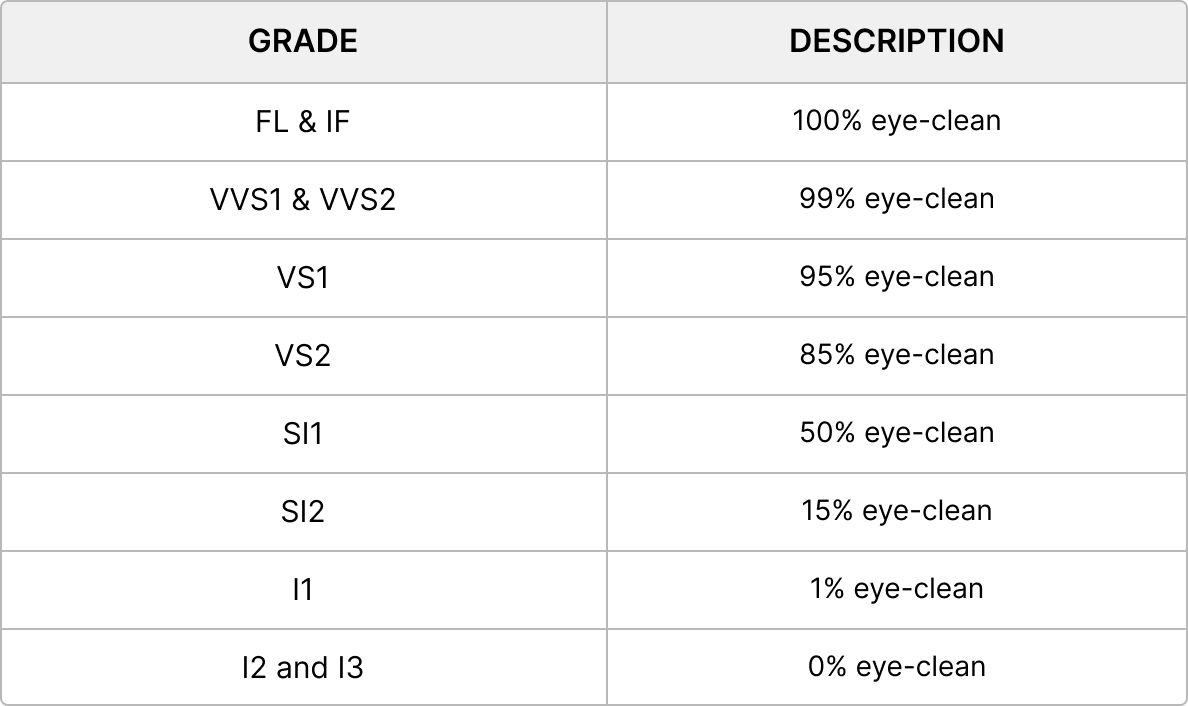
Note: The above percentages are for a 1 carat round cut diamond.
Based on the chart, the FL-VS2 range has the best clarity diamonds in the one-carat diamond segment. Also, you need to understand that as the size of the diamond increases, eye cleanliness varies. Imperfections are clearly visible in larger carat diamonds.
Further, clarity also depends on the diamond shape. For example, emerald cut diamonds cannot mask inclusions. Their step-cut pattern, intended to show off more clarity and color, makes inclusions visible prominently. You may have to choose VVS1 or VVS2 grade for the best clarity diamonds
Can There Be Different Gradings for the Same Diamond?
When selecting a diamond, you must understand that the diamond grades are subjective. Each gemological lab takes various parameters into account and uses different techniques to identify the flaws. This leads to different labs providing different grades for the same diamond in rare cases. For example, one lab may grade a diamond as SI1, and another may deem it as SI2.
GIA and IGI follow strict standards for grading diamonds and hence, are most reliable.
The Best Diamond Clarity to Choose
Everything said, the choice of the best clarity diamond comes down to your requirements. If you want high-clarity diamonds and do not want to overpay, VS1 and VS2 grade lab diamonds are the best. They are as eye-clean as FL or IF diamonds to the naked eye.

SHOP LAB DIAMONDS
If beauty is your criteria, you must choose diamond shapes that hide the imperfections. For example, round cut diamonds are best at keeping inclusions invisible. You can choose between VS1 and SI1 clarity grades for a one carat round cut diamond. Similarly, cushion, radiant, oval, and princess cuts are other diamond cuts that perfectly hide the inclusions.
And if affordability is in your mind, even SI1 and SI2 lab diamonds, which are fairly eye-clean, can be a good choice.
All we advise you is to have a careful look at a diamond for inclusions or blemishes. Observe whether it is eye-clean, and do not overpay.
Try Our Lab Diamonds!
When perfection is a rarity in the world, the next best choice is to choose slightly imperfect. Lab diamonds from Friendly Diamonds have their share of imperfections. Yet, you can get the best quality diamonds as per industry standards at highly affordable prices. With very few inclusions and minimal blemishes, we offer diamonds with high eye-clean grades.
Try our lab diamonds now and feel the difference!

















